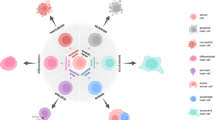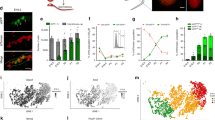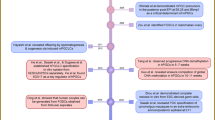Abstract
Stem cells maintain populations of highly differentiated, short-lived cell-types, including blood, skin and sperm, throughout adult life1. Understanding the mechanisms that regulate stem cell behaviour is crucial for realizing their potential in regenerative medicine2. A fundamental characteristic of stem cells is their capacity for asymmetric division: daughter cells either retain stem cell identity or initiate differentiation. However, stem cells are also capable of symmetric division where both daughters remain stem cells3,4,5,6, indicating that mechanisms must exist to balance self-renewal capacity with differentiation. Here we present evidence that support cells surrounding the stem cells restrict self-renewal and control stem cell number by ensuring asymmetric division. Loss of function of the Drosophila Epidermal growth factor receptor in somatic cells disrupted the balance of self-renewal versus differentiation in the male germline, increasing the number of germline stem cells. We propose that activation of this receptor specifies normal behaviour of somatic support cells; in turn, the somatic cells play a guardian role, providing information that prevents self-renewal of stem cell identity by the germ cell they enclose.
This is a preview of subscription content, access via your institution
Access options
Subscribe to this journal
Receive 51 print issues and online access
$199.00 per year
only $3.90 per issue
Buy this article
- Purchase on Springer Link
- Instant access to full article PDF
Prices may be subject to local taxes which are calculated during checkout





Similar content being viewed by others
References
Loeffler, M. & Potten, C. S. in Stem Cells (ed. Potten, C. S.) 1–27 (Academic, London, 1997).
Weissman, I. L. Translating stem and progenitor cell biology to the clinic: barriers and opportunities. Science 287, 1442–1446 (2000).
Morrison, S. J., Wandycz, A. M., Hemmati, H. D., Wright, D. E. & Weissman, I. L. Identification of a lineage of multipotent hematopoietic progenitors. Development 124, 1929–1939 (1997).
Green, H. Cultured cells for the treatment of disease. Sci. Am. 265, 96–102 (1991).
Parreira, G. G. et al. Development of germ cell transplants in mice. Biol. Reprod. 59, 1360–1370 (1998).
Xie, T. & Spradling, A. C. decapentaplegic is essential for the maintenance and division of germline stem cells in the Drosophila ovary. Cell 94, 251– 260 (1998).
Hardy, R., Tokuyasu, T., Lindsley, D. & Garavito, M. The germinal proliferation center in the testis of Drosophila melanogaster . J. Ultrastruct. Res. 69, 180– 190 (1979).
Lindsley, D. & Tokuyasu, K. T. in Genetics and Biology of Drosophila (eds Ashburner, M. & Wright, T. R.) 225– 294 (Academic, New York, 1980).
Gönczy, P. Towards a molecular genetic analysis of spermatogenesis in Drosophila. Thesis, Rockefeller Univ., New York (1995).
Kumar, J. P. et al. Dissecting the roles of the Drosophila EGF receptor in eye development and MAP kinase activation. Development 125, 3875–3885 (1998).
Lin, H., Yue, L. & Spradling, A. S. The Drosophila fusome, a germline specific organelle, contains membrane skeletal proteins and functions in cyst formation. Development 120, 947–956 (1994).
de Cuevas, M. & Spradling, A. C. Morphogenesis of the Drosophila fusome and its implications for oocyte specification. Development 125, 2781–2789 ( 1998).
Whiteley, M., Noguchi, P. D., Sensabaugh, S. M., Odenwald, W. F. & Kassis, J. A. The Drosophila gene escargot encodes a zinc finger motif found in snail-related genes. Mech. Dev. 36, 117–127 (1992).
McKearin, D. & Ohlstein, B. A role for the Drosophila Bag-of-marbles protein in the differentiation of cystoblasts from germline stem cells. Development 121, 2937– 2947 (1995).
Gönczy, P., Matunis, E. & DiNardo, S. bag-of-marbles and benign gonial cell neoplasm act in the germline to restrict proliferation during Drosophila spermatogenesis. Development 124, 4361– 4371 (1997).
Brand, A. H. & Perrimon, N. Raf acts downstream of the EGF receptor to determine dorsoventral polarity during Drosophila oogenesis. Genes Dev. 8, 629–639 (1994).
Tran, J., Brenner, T. & DiNardo, S. Somatic control over the germline stem cell lineage during Drosophila spermatogenesis. Nature 407 , 754–757 (2000).
Gabay, L., Seger, R. & Shilo, B. -Z. MAP kinase in situ activation atlas during Drosophila embryogenesis. Development 124, 3535–3541 (1997).
Wasserman, J. D. & Freeman, M. An autoregulatory cascade of EGF receptor signaling patterns the Drosophila egg. Cell 95, 355–364 ( 1998).
Wessells, R. J., Grumbling, G., Donaldson, T., Wang, S. H. & Simcox, A. Tissue-specific regulation of vein/EGF receptor signaling in Drosophila. Dev. Biol. 216, 243–259 (1999).
Golembo, M., Yarnitzky, T., Volk, T. & Shilo, B. Z. Vein expression is induced by the EGF receptor pathway to provide a positive feedback loop in patterning the Drosophila embryonic ventral ectoderm. Genes Dev. 13, 158–162 ( 1999).
Bonini, N. M., Leiserson, W. M. & Benzer, S. The eyes absent gene: genetic control of cell survival and differentiation in the developing Drosophila eye. Cell 72, 379–395 ( 1993).
Kimble, J. & White, J. G. On the control of germ cell development in Caenorhabditis elegans. Dev. Biol. 81, 208–219 (1981).
Cox, D. N. et al. A novel class of evolutionarily conserved genes defined by piwi are essential for stem cell self-renewal. Genes Dev. 12, 3715–3727 (1998).
King, J. F. & Lin, H. Somatic signaling mediated by fs(1)Yb is essential for germline stem cell maintenance during Drosophila oogenesis. Development 126, 1833– 1844 (1999).
Meng, X. et al. Regulation of cell fate decision of undifferentiated spermatogonia by GDNF. Science 287, 1489– 1493 (2000).
Clifford, R. J. & Schupbach, T. Coordinately and differentially mutable activities of torpedo, the Drosophila melanogaster homolog of the vertebrate EGF receptor gene. Genetics 123, 771–787 (1989).
Hime, G. R., Brill, J. T. & Fuller, M. T. Assembly of ring canals in the male germ line from structural components of the contractile ring. J. Cell Sci. 109, 2779–2788 (1996).
Lee, T. & Luo, L. Mosaic analysis with a repressible cell marker for studies of gene function in neuronal morphogenesis. Neuron 22, 451–461 ( 1999).
Acknowledgements
We thank J. Kumar and K. Moses for the Egfrts allele; S. DiNardo, D. Traver, S. Kim and Fuller lab members for communication of unpublished data and helpful comments; and the Howard Hughes Medical Institute (A.A.K.) and the National Institutes of Health (M.T.F.) for financial support.
Author information
Authors and Affiliations
Corresponding author
Rights and permissions
About this article
Cite this article
Kiger, A., White-Cooper, H. & Fuller, M. Somatic support cells restrict germline stem cell self-renewal and promote differentiation. Nature 407, 750–754 (2000). https://doi.org/10.1038/35037606
Received:
Accepted:
Issue Date:
DOI: https://doi.org/10.1038/35037606
This article is cited by
-
Cyst stem cell lineage eIF5 non-autonomously prevents testicular germ cell tumor formation via eIF1A/eIF2γ-mediated pre-initiation complex
Stem Cell Research & Therapy (2022)
-
Somatic CG6015 mediates cyst stem cell maintenance and germline stem cell differentiation via EGFR signaling in Drosophila testes
Cell Death Discovery (2021)
-
CG6015 controls spermatogonia transit-amplifying divisions by epidermal growth factor receptor signaling in Drosophila testes
Cell Death & Disease (2021)
-
Upregulated TNF/Eiger signaling mediates stem cell recovery and tissue homeostasis during nutrient resupply in Drosophila testis
Scientific Reports (2020)
-
The Progresses of Spermatogonial Stem Cells Sorting Using Fluorescence-Activated Cell Sorting
Stem Cell Reviews and Reports (2020)
Comments
By submitting a comment you agree to abide by our Terms and Community Guidelines. If you find something abusive or that does not comply with our terms or guidelines please flag it as inappropriate.



